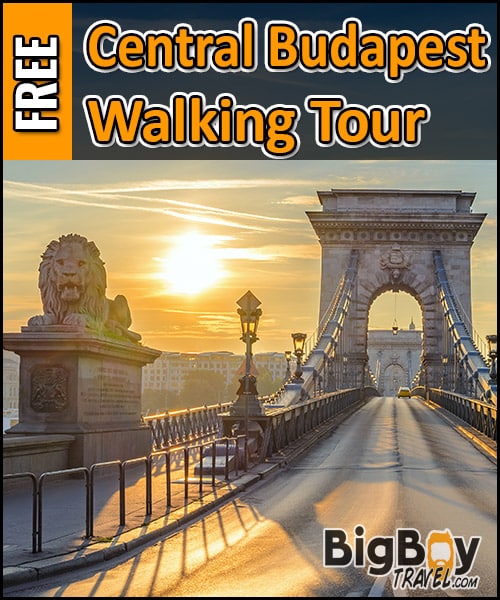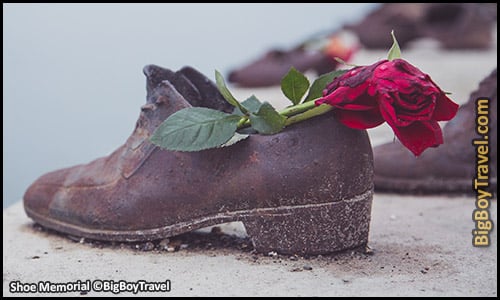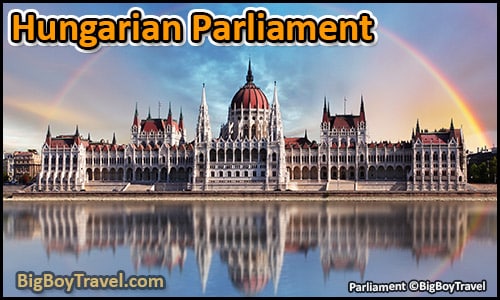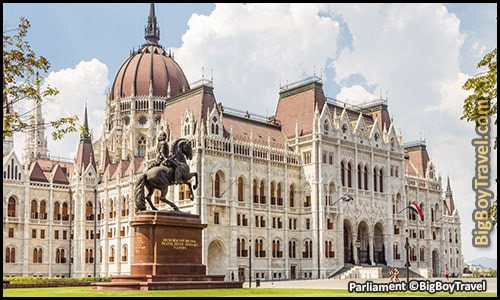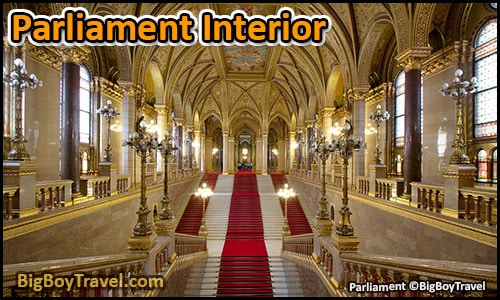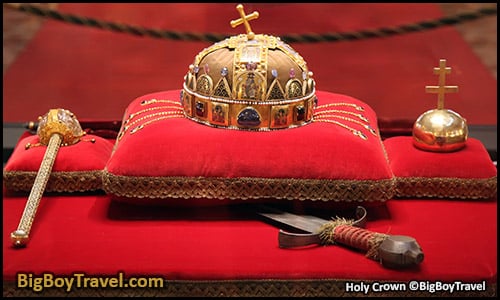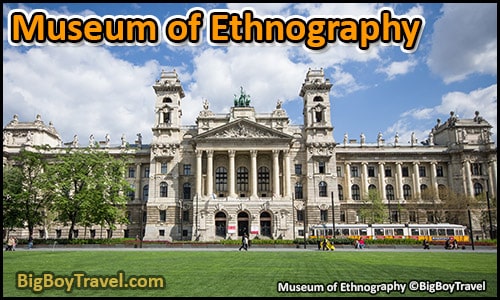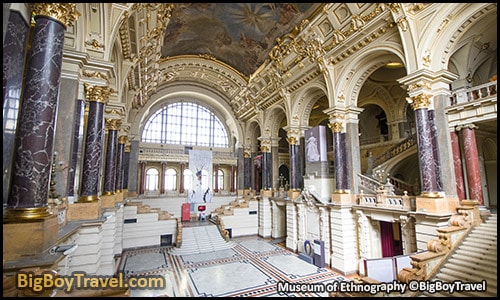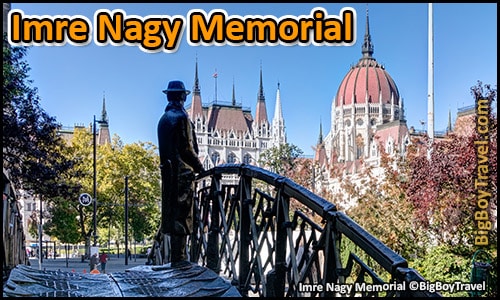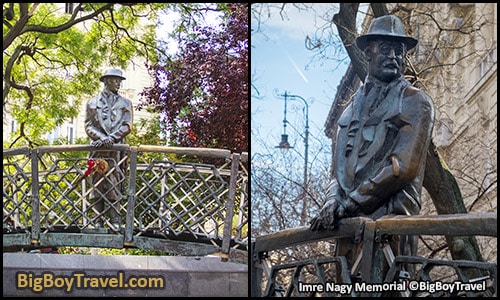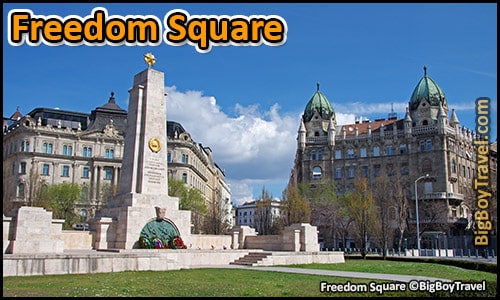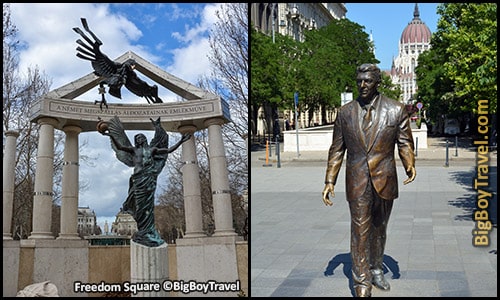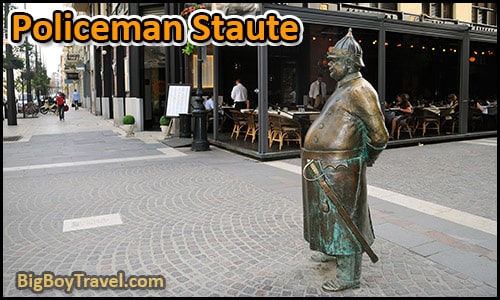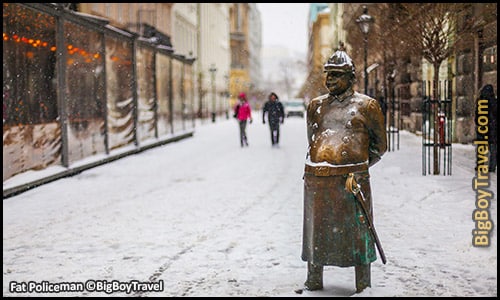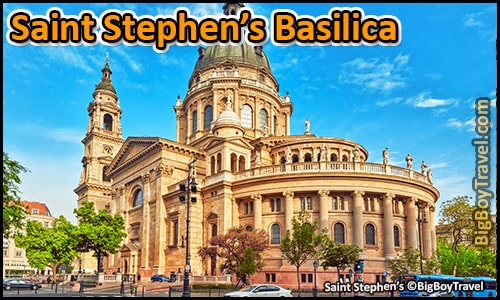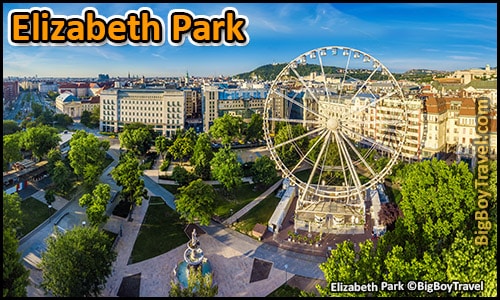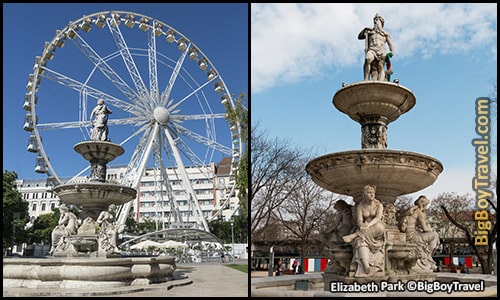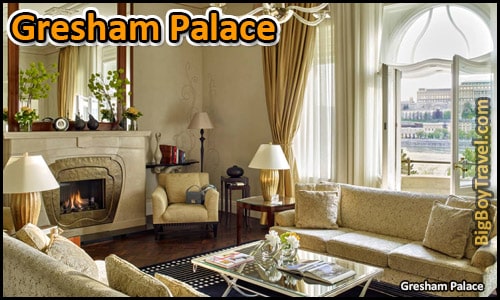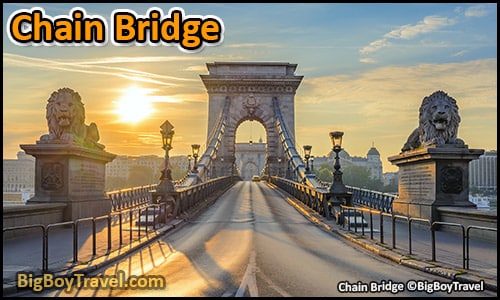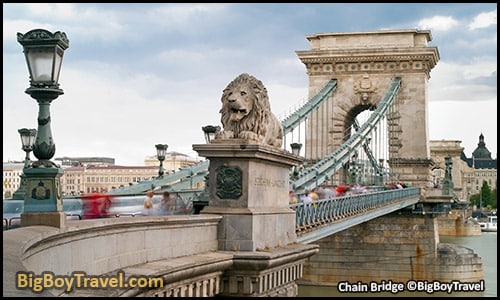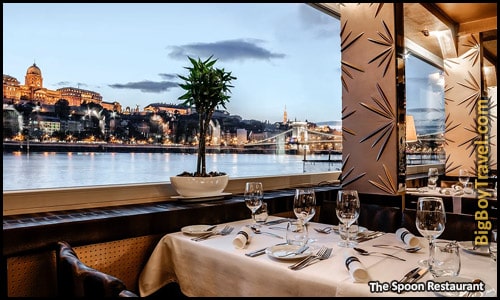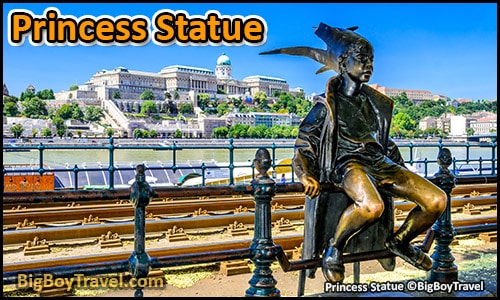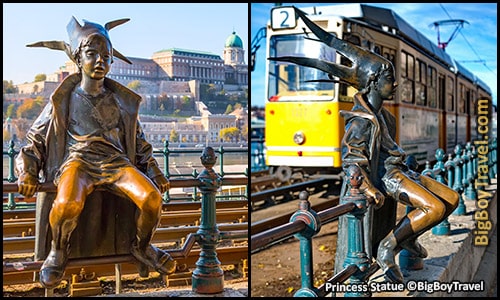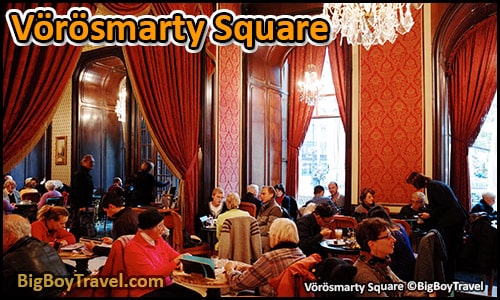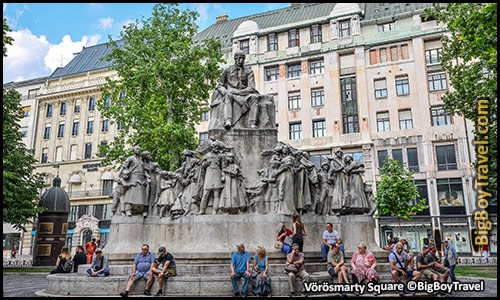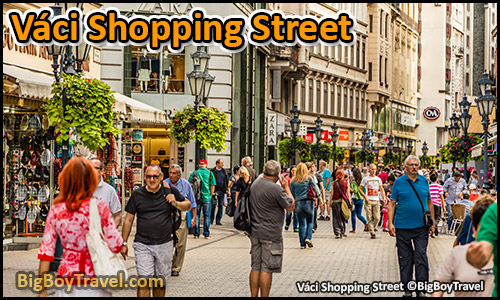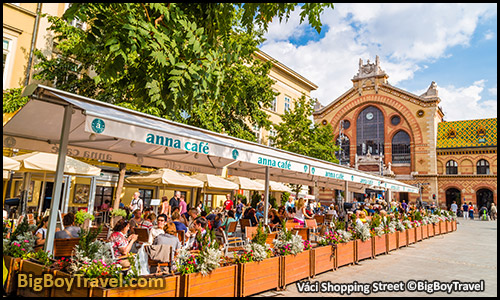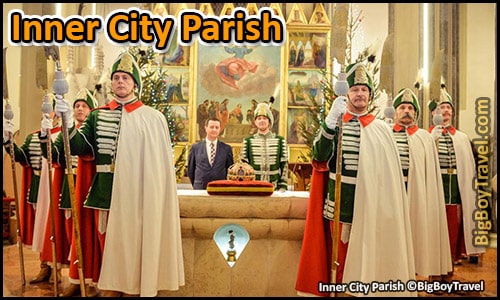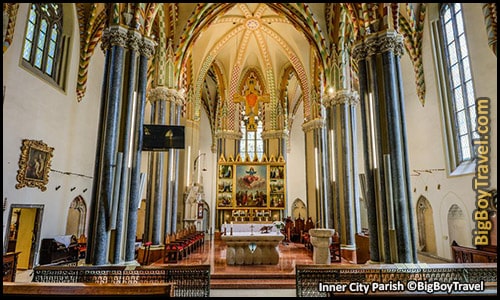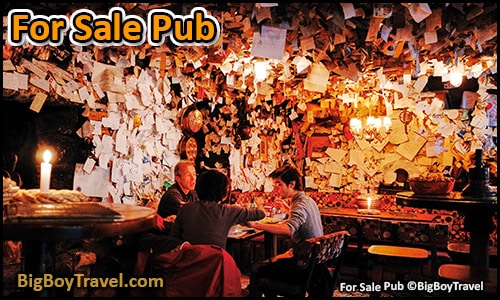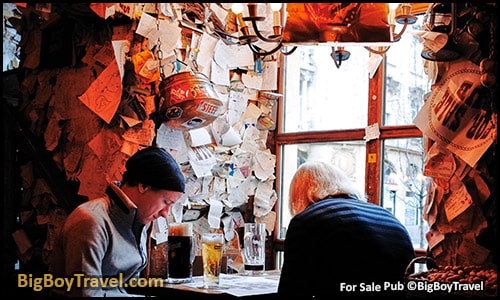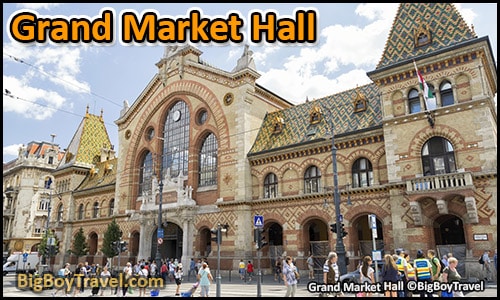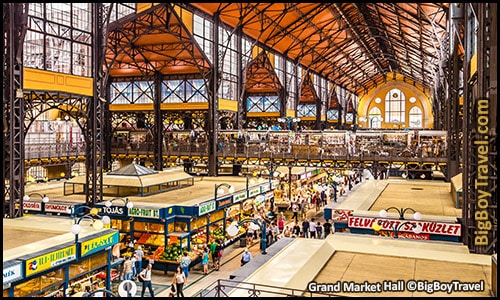Free Budapest Walking Tour:
Location: Pest (East Side of Danube River)
Cost: Free, Self-Guided (Museum and sight costs below)
Style: Do-It-Yourself Walking Tour (Self Guided)
Start: Holocaust Shoe Memorial
Stop: Grand Market Hall
Walking Distance: 3 Miles
Time: 1 hour of walking (4 hours with sights; +1 hour for Parliament Tour)
Fun Scale: 9 out of 10
Central Pest Overview:
Sitting of the Eastern bank of the Danube River is Budapest’s lively and history Pest neighborhood. Pest was founded in was an economic powerhouse in the 11th-13th Centuries until it was sacked by the Mongols in 1241. The city made a comeback through the Middle Ages which later lead to grand buildings and cathedrals. After severe flooding spread 8 feet of water through Pest, it merged with Buda and Óbuda on the Western bank in 1873.
Even through all of the changes and wars, Pest has retained many historic monuments like Saint Stephen’s Basilica and the Hungarian Parliament to remain the heart of Budapest. Our self-guided walking tour through central Pest is the perfect way to get a feel for the Budapest’s history. Different sights will highlight Pest’s war-torn past, the days of power grandeur, plus an easy to love culture and flair.
Pest Walking Tour Sights:
1. Holocaust Shoe Memorial:
About The Holocaust Shoe Memorial: On first glance, the Holocaust Shoe Memorial looks like just a collection of bronzed shoes by the waterside, but knowing the history of this spot makes a visit truly moving. During WWII, the Nazi’s secret police group Arrow Cross often executed Jews and other citizens here by shooting them then pushing them into the Danube River. All of the victims were required to line up and take their shoes off not knowing which of them would be shot. When the Nazis wanted to save bullets they would tie a few people together, shoot one, push the group into the freezing river, and watch the dead bodies drag the entire group down. The Memorial’s 60, 1940’s era shoes represent the shoes left behind by the fallen Arrow Cross victims and you really should not missed it.
As you walk North along the river the big white mansion on your right is the Office of the Prime Minister. The building once was a mansion for Hungarian aristocrats, and the grandmother of US Sectary of State and former Presidential candidate John Kerry’s grandmother was born here as a daughter of the chambermaid.
2. Hungarian Parliament Building:
About The Hungarian Parliament Building: The huge Gothic-style Hungarian Parliament, or House of the Nation, is the formal seat of government for Hungary and the most photographed monument in Budapest. The massive 315-foot-tall and 879-foot-long building is a symbol of Hungary’s power as it dominates the Eastern bank of the Danube River. The Parliament’s silhouette of the white Gothic spires, red domes, and 242 sculptures is breathtaking.
Construction of the Parliament started shortly after Budapest was united out of three cities (Óbuda, Buda, and Pest) in 1873 to centralize Hungary’s government. Although it wasn’t completed until in 1904, the building was symbolically consecrated 1896 to mark the 1,000th anniversary of the country being formed. It is impossible to not be impressed by the grandeur of the Hungarian Parliament with its exterior spires and interior filled with carved woodwork, stained glass windows, Gothic arches. We will talk more about the interior of the Parliament next on this free Budapest walking tour, but first we want to point out a few other of the interesting exterior features you should know about.
On the North side of the Hungarian Parliament Building is a small park with a memorial statue from 1975 for controversial former president Károlyi Mihály (ruled from 1918-19). Early in his political career, Mihály was credited with helping give women, veterans, and other citizens the right to vote in 1915. He became Prime Minister after opposing the previous leader (who got them into WWI), and then quickly turned Hungary into a democracy. With an anti-war mindset, Mihály pushed for Hungary to make peace with the Allied Nations to end WWI, but was forced out of power after his efforts led to too many territory concessions. In the end, Hungary did have to give up further land to end the war with the Peace Treaty of Trianon which also led to a long economic decline. With these negative circumstances considered, modern Hungarians look past the bad things under Mihály and honor the good intentions he had for the country.
Another larger statue around the Parliament grounds is of former president Lajos Kossuth (ruled from 1848-49) on a red stone pedestal directing both the people and the army. Kossuth was the President through the Revolution of 1848-49 and was a strong social advocate who signed the first law which recognizing minority rights in Europe. The inscription at the memorial calls him “Father of Hungarian Democracy, Hungarian Statesman, Freedom Fighter”.
3. Hungarian Parliament Interior:
About The Hungarian Parliament Interior: While we love the admire the Parliament Building from every possible angle on the outside, you really need to see the gorgeous interior. In total there are 10 courtyards, 28 staircases, and 691 rooms inside the massive complex.
On a tour of the interior of the Hungarian Parliament you will see some of the most beautiful rooms for 50 minutes with a guide. The tours start with a walk down the gold-plated Staircase XVII framed by statues, stained glass. Old Upper House Hall which has colorful paintings of Hungary’s royal families and murals depicting the historical role of the nobility in a medieval beer hall style room. This leads to the Upper House Lobby which is the most exotic space in the Parliament resembling the inside of an Ottoman Sultan’s palace. The large wrap around murals in both the Nándorfehérvár and Munkácsy Halls are also very impressive with their depictions of religious and battle scenes.
Reaching the geometric center of the House of Parliament and the symbolic center of Hungary, you enter the sixteen-sided Dome Hall. Since 2000 this vast space is has been home to the Holy Crown Of Hungary protected 24 hours a day by two royal guards. The Byzantine-style royal crown dates back to the between 1031-1070s, was made in Constantinople (modern-day Istanbul), and was used to coronate over 50 Hungarian Kings. Make to look up at the stunning ceiling while inside the Dome Hall which looks like a radiant sun beaming light down on you.
We love the main corridors filled with statues representing the different Medieval professions from horse herders to stonecutters, but the Grand Stairway is the most impressive space. The combination of arches, ceiling murals, and lighting make the Grand Stairway feel like the inside of an old-world castle.
General Hours: April-October 8am-6pm; November-March 8am-4pm. Guided Tours: 50-minute tours leave from the underground entrance on the park side of the building toward the East (away from the river). Tours in English at 10am, Noon, 1pm, 1:45pm & 3pm; many other languages available throughout the day. Tour Cost: 6000 HUF for Adults; 2400 HUF for EU Citizens; Students Half price; Kids 6 & Under Free. Buying Tickets: Tickets can be purchased in advance to save yourself waiting in line and can sell out if you don’t buy in advance. Parliament Website: (HERE).
4. Museum of Ethnography (Neprajzi Muzeum):
About The Museum of Ethnography: The Museum of Ethnography is a great way to get an eclectic mix of cultures throughout the World all in one building. They have a diverse collection of more than 200,000 ethnographic artifacts, as well as historical photographs, manuscripts, folk music recordings, and videos of everything you can think of. Its European collection covers every ethnic group on the continent, its Oceania and Africa Collections are assembled by famous Hungarian world travelers and ethnologists, and its collections of authentic artifacts from America, Asia, and Indonesia, are also pretty awesome.
The palace-like building housing the Museum of Ethnography was actually first built for the Department of Justice in the 1800s as a Supreme Court, and supreme it is. Its grand style and richly ornamented interior reflect the powerful place Hungary’s government occupied in Europe in the 1800s. The museum was moved here in 1973 and it just seems like a perfect fit. You’ll be wowed from the second you step into the dimly lit grand hall and entertained through the last exhibit. Adults seem to appreciate the collects more than kids do.
Hours: Tuesday-Sunday 10am-6pm; Closed Mondays. Cost: 1000 HUF; 500 HUF for EU Citizens; special exhibit combo tickets are usually 200 HUF more. Guided Tours: Available in numerous languages and 8,000 HUF covers a group up to 25 people. Museum Website: (HERE).
Closure Notice: The museum is closed for renovations and will re-open sometime in 2020.
5. Imre Nagy Memorial:
About The Imre Nagy Memorial: Located in the middle of the small leafy Martyrs Square (Vértanúk Tere) is the Imre Nagy Memorial consisting of a cozy footbridge and the former leader symbolically looking out over Parliament. Nagy was Prime Minister of Hungary during the anti-Soviet Revolution of 1956 when many Hungarian Citizens fought to get rid of Soviet influence. The Revolution was foiled but Nagy shared the group’s views and took action to make his Communist government neutral from both the Soviets and Stalin. The biggest step he took was when he withdrew from the Warsaw Pact and asked the United Nations to recognize Hungary and a neutral 3rd party. He also took steps to open the Hungarian Government up to a multi-party system although he remained himself a Marxist.
The steps Nagy took faced a lot of hostility as the Soviets had helped liberate Hungary from the Nazis at the end of WWII and many Government officials were still loyal to the USSR. Because of these strong loyalties, Nagy was arrested for treason in 1958, tried secretly, executed by hanging, and was buried in an unmarked grave. Many viewed this as a message from the USSR to other Communist leaders of what would happen if they started growing away from them. The corruption involved was obvious since the same man who had Nagy tried for treason (János Kádár) became the next Prime Minister. Over the following 30 years of Communist rule, it became illegal to utter Nagy’s name as he was viewed as a martyr and symbol of freedom. After Communism fell in 1989, Nagy was reburied and a crowd of over 200,000 people gathered in Heroes’ Square near Budapest’s City Park for his funeral.
6. Freedom Square (Szabadság Tér):
About Freedom Square: Named after the freedom fighters who were executed here in the 1840s, Freedom Square is actually the former site of a military barracks. The main highlight of the square is the Soviet Monument dedicated to the Soviet’s Red Army troops who liberated Hungary from the Nazis at the end of WWII. A standing Soviet Monument is really quite rare in Budapest as most Communist statues were moved to Memento Park outside of town when Hungary became a true Democracy in 1989. While most modern-day Hungarians seem to want the Soviet Monument removed, try to view the monument as more of a celebration for the Nazis being kicked out than as an honor for Soviets coming in. The square also holds other monuments to freedom including a statue of Ronald Regan who was the US President the year Communism ended in Hungary.
7. The Fat Policeman Statue:
About The Fat Policeman Statue: The iconic bronze statue of the Fat Policeman is one of many good luck statues you will see on this free Budapest walking tour. The statue was added along Zrínyi Street in 2008 by artist Illyés András who used his own grandfather as inspiration. The exaggerated features of the Fat Policeman, especially the huge belly, are meant to show how hearty the Hungarian foods like goulash are. It has become a tradition to rub the gut of the Fat Policeman for good luck which keeps like belly a shiny gold color.
8. Saint Stephen’s Basilica (Szent István Bazilika):
About Saint Stephen’s Basilica: The two towers and large dome of the huge, 315 foot tall Saint Stephen’s Basilica towers of the large open square around it. This powerful church is named after Stephen, the first King of Hungary (975–1038), whose mummified fist is still housed in the reliquary. His first is known locally as the Holy Right and can be seen in the back of the church mummified and holding jewels. The display is dark and they make you pay 100 HUF to light it up which is pretty weird, but worth it. If you are looking to see it for free you have to be in town on August 20th known as St Stephen Day when they have the hand attend services and also lead the parade in his honor.
As you can imagine with a church this big the construction, which started in 1851, didn’t go as smooth as they wanted. The first dome collapsed 17 years after the groundbreaking and then the second architect Miklos Ybl, who also built the Opera House, died. It seemed like the church was doomed, but finally they got it all together 50 years after the groundbreaking. After the stabilized Church was finally standing strong, the best painters and sculptures in Hungary came in to finish off the masterpiece.
The interior today is a great mix of light and dark, stone and wood, marble and gilding to combine into a very impressive church. We highly suggest swinging by the treasury, twin bell towers, and Szent Jobb Chapel. Among the two bell towers, the left tower has one of the better panoramic views of Budapest and the right tower houses a giant 9-ton church bell. Which one you choose depends on what you want to see.
Visitor Hours: Church is open Daily 7am-7pm; Treasury is 9am-5pm (10am-4pm in winter); Szent Jobb Chapel 9am-5pm (Sundays 1pm-5pm); Tower daily 10am-4:30pm (July-September until 6pm). Cost: Church Free; Treasury 400 Ft; Tower 500 Ft. Church Services: Daily 8am, 530pm, & 6pm; Sunday Mass is at 8am, 9am,10am, Noon, 6pm, & 7pm. Church Website: (HERE).
9. Elizabeth Park (Erzsébet Tér):
About Elizabeth Park: Elizabeth Park is a great park to visit any day of the week and is extra busy on the weekends. The area is busy not just because it is a large beautiful and hip park, but also because it is a cross roads for three different Metro Lines which leads to a very eclectic crowd. The West side of the Square is more of a laid-back standard park area with trees and fountains while the East side is definitely the bustling, young, hip area. Adding to the hipness of the East side are a large look-like pond and multi-level terraces filled with outdoor furniture.
This area is surrounded by numerous cafes where you can grab a bit to eat or a drink. Many locals bring their own wine in the evening and drink around the pond. Also on the East side, there are the two popular bars/nightclubs called Gödör Klub (website) and Akvárium Klub (website). We love both of them, but end up spending more time in Akvárium as we really like their outdoor fit pits in the Winter. The funky band memorabilia and Volt signage in the lobby of Akvárium comes from the annual Volt Musical Festival they help promote in Western Hungary which 80,000 people go to.
Just off of the Southeast corner of the Park is the giant yellow Anker Mansion House which was built as the first apartment building in Budapest in 1907. The two-towered building, with its pyramid roof, gets its name from the Anker Life and Pension Insurance Company which first built it.
10. Gresham Palace Four Seasons Hotel:
About Gresham Palace: Overlooking Roosevelt Park at the foot of the famous Chain Bridge, is the architectural treat called Gresham Palace. The Palace was built in 1906 as the grand headquarters for the foreign Gresham Life Insurance Company and they spared no expense. The headquarters were built so fancy that tons of wealthy British aristocrats all spent time living on the upper floors.
During WWII the Soviets used Gresham Palace to house troops and after the war, the damaged building served as a rundown apartment complex. Finally, after over 50 years of falling apart, the Four Season’s Hotel chain bought the property and quickly restored to its original grandeur. Today the Palace serves as a great backdrop to Roosevelt square and offers great views of Castle Hill which is directly across the Danube River. Even if you can’t afford its $400+ a night rooms, a brief stroll through the magnificent lobby will leave you in awe.
Sitting in front of Gresham Palace is a long park called Roosevelt Square. On the North side of the Park statue of Count István Széchenyi (1791-1860) who founded the Hungarian Academy of Sciences and also originally thought up nearby Chain Bridge. The Southside has its own statue of Ferenc Deák (1803-1876), who advanced relations between Austria and Hungary and had the nickname “Wise Man”. Hotel Website: (HERE).
11. Chain Bridge (Széchenyi Lanchid):
About The Chain Bridge: The historic quarter-mile long Chain Bridge was completed in 1849 as the first permanent bridge connecting Buda and Pest. The bridge was needed to help Pest escape constant flooding and led to the city merging with Buda and Óbuda to form Budapest in 1873. With large lion statues guarding all four corners of the Bridge, its easy to feel its power. Great photo opportunities come not only from the statues but also from the Chain Bridge itself with the breath-taking Buda Hills & Royal Palace in the background. The Chain Bridge is absolutely gorgeous when it is lit up at night.
If you only have a short amount of time in Budapest we suggest that your break this free Budapest Walking Tour off here and follow the Chain Bridge across the Danube River to follow our Castle Hill Walking Tour. If you have a few days in Budapest, however, continue on this tour taking your time and visit Castle Hill later.
12. The Spoon Restaurant:
About The Spoon Restaurant: The Spoon is an amazing restaurant inside a docked boat right on the Danube River. The setting on the water is especially beautiful at night. Whether you are looking for a romantic dinner or just a beautiful place to get a drink we highly suggest the Spoon. The-250 foot-long three level riverboat has two restaurants, five bars, a panoramic open terrace, convertible winter garden, and an underwater Oriental bar. The Spoon remains docked the entire year so it’s always there and has a lot of outdoor seating plus posh inside seating. It’s worth buying a drink or food just to be able to check The Spoon out and take some photos especially if you go down into the Red Velvet Oriental Bar on the bottom level.
Depending on your taste for the menu there is also a second really good boat restaurant right next door to The Spoon called the Vén Hajó (website). After your visit, we suggest taking the crosswalk between the two boat restaurants to reach the steps that will up the opposite side of the tram tracks. Crossing here is the easiest way to continue with the rest of the sites on the free Budapest walking otherwise you will have to go down the riverfront a long distance for the next set of steps.
Cost: High end drinks average $6-15; Meals are $10-20. Hours: Daily Noon-Midnight. Restaurant Website: (HERE).
13. Royal Princess Statue (Kis Királylány):
About The Royal Princess Statue: Often referred to as the Jester, the bronze Royal Princess Statue is one of the top photo opportunities in Budapest with the Danube River and Royal Palace in the background. The artist, László Marton, modeled the famous statue after his daughter who often dressed with a paper newspaper crown to pretend to be a princess. The original Royal Princess Statue can be seen at the Hungarian National Gallery and this larger replica was created added near the tram tracks in front of Vigado Square in 1990.
Like the Fat Policeman Statue’s belly from earlier on this free Budapest walking tour, the Princess has gained polished golden knees from visitors rubbing her for good luck. The artist, László Marton, also has a noteworthy statue of poet Attila József sitting on the riverside steps not far from the Hungarian Parliament Building. On a trip to Budapest, Prince Charles of England liked the Royal Prince Statue so much he had a replica made for his residence in London.
14. Vörösmarty Square:
About Vörösmarty Square: As you enter the large Vörösmarty Square you will find a huge limestone statue of writer Mihály Vörösmarty, who the Square is named after. Vörösmarty gained his fame not just from his romanticized poems and plays, but also for his patriotic lyrics making him a national treasure. The statue was built in 1908 on a pedestal of limestone blocks and is surrounded by tons of figures representing different classes of Hungarian society. These figures include a farmer, students, peasants among many others. Vörösmarty’s writings were both appealing to and made up of a very wide range of people as you can tell by the diversity of the figures who surround him.
The Square is also home to the Vörösmarty tér Metro Stop, but it is the beautiful Gerbeaud Café (website)opened in 1858 that you will remember the most. Gerbeaud Café is a delightful pastry shop with a lavish marble and ornate interior whose white facade dominated the Square. If pastries are not your thing, Gerbeaud also has a nice authentic pub and a great high-end restaurant that will make you feel like a Hungarian aristocrat. Gerbeaud can hold up to 300 guests inside and also has great outdoor seating, so don’t worry about getting served if you see a crowd, there is plenty of room for everyone. You can always get something to go and do a makeshift picnic.
Our favorite time of year to visit Vörösmarty Square is in December when you’ll be treated to a number of great outdoor stands that make up Budapest’s Christmas Fair and Market. The Market has the perfect look and feels just like the large Christmas markets of Austria and Germany.
15. Váci Shopping Street (Váci Utca):
About Váci Utca: The pedestrian-only Váci Street is the best shopping area in all of Budapest and stretches all the way from Vörösmarty Square to the Great Market Hall. The architecture along the street is some of the best from the 1700s, the atmosphere is always upbeat, and there is a great mix of both affordable souvenir shops and high-end fashion boutiques. If you wander slightly off Váci Utca, in almost any direction, you can find a great number of mom-n-pop style eateries that have great deals and even better food.
Speaking of food, notice the Historic McDonald’s on your right as you begin down Váci, it is a big deal. This McDonald’s was the first Western fast food restaurant built in the Communist East Block when is came here in 1988. The people of Budapest were so excited for McDonald’s to be here that the line to get food typically ran outside the restaurant and down the road a few blocks. McDonald’s went on to build what we feel is their fanciest restaurant in the World to the Northeast of here near the train station, which is also marked on the map above.
While the McDonald’s and the shopping on Váci Utca are special, the most unique thing is definitely the statue of the Peeing Boy. It is quite literally is a statue of a peeing boy and serves as a gathering spot for travelers looking to rest their feet. As you continue down the street make sure to investigate numerous statues you come across.
16. Roman Fortress Ruins (Contra Aquincum):
About Contra Aquincum: The Roman city of Aquincum (modern Óbuda) was founded just up the river from here on the opposite bank of the Danube in 41AD and became the capital of the state of Pannonia in 106AD. This elevated status made Aquincum a target of rival Barbarian groups which led to the need for greater protection. A large fortress called Contra Aquincum was built here in the early 100s AD to serve as the first line of defense for the regional capital.
Interestingly the Contra Aquincum was built on the Barbarian side of the Danube which was not fully controlled by the Romans. The placement of the fortress on just beyond the Roman borders at the edge of the frontier made it very important. When Roman Emperor Diocletian visited in 296AD he ordered the fortress be massively re-enforced. It was common for Emperors to visit Budapest and many did starting with Domitian in 86AD through Valentinian I in 374AD.
After the Romans left, the Hungarians continued to use Contra Aquincum for defense until around just after the country was officially founded in 896AD. A settlement began to grow around the former fortress which sparked the true beginning of the city of Pest. Much of the village and the remains of the fortress were ravaged in the Mongol Invasion of 1241, but the city continued to grow. In Medieval times a wall protected Pest and on any modern map you see a natural half circle in the road (Károly > Múzeum > Vámház) 5 blocks out from the river where the wall enclosed the Inner City of Pest.
Through the plexiglass viewpoints middle of Március Square, you can still see parts from the original Contra Aquincum Fortress sitting just below the pavement. These Roman ruins used to be open air, but had to be covered in the early 2000s to protect them from vandalization. If you are further interested in the Roman history of Budapest you can visit the ruins of the former regional capital Aquincum just North of the city with an easy 20-30 minute metro ride from the center of town.
17. Inner City Parish (Belvárosi):
About Inner City Parish: Rebuilt numerous times over the centuries, the Inner City Parish was the heart of the neighborhood of Pest in Medieval times. In as early as 296 this location was the watchtower for the Roman Contra-Aquincum Fortress and was then a massive military control room by 350. When the Romans left, a small village (Pest) began to form around the old fortress. Shortly after Hungary officially formed in 896 the fortress was no longer needed and the first church was built here in the 11th century by Hungary’s first King Saint Stephen (1000-1038) to honor the Virgin Mary.
The original Inner City Parish was made of stone with three naves and was said to have inspired other famous churches like the hand-carved Ják Abbey. This early church was where the monk Saint Gellért was buried after he was martyred just across the river on Gellért Hill in 1046. Saint Gellért (Gerard of Csanád) had been put in a barrel and rolled to his death by citizens resisting his attempts to convert them to Christianity. The church even had to be extended in 1053 to hold all of the new relics from Saint Gellért (who was a mentor of King Stephen). Some of his foot bones and vertebra can be still found at the altar Inner City Parish even though much of the original church which was destroyed by the Mongols in 1241. There are also bones from Hungarian Princess Elizabeth (1207-1239) who was engaged in the church to Saxon count at age four. Our favorite remnant on display from this era of the church is a marvelous fresco of the Virgin Mary sitting in a throne.
A second church was built here in the Gothic-style and was famously where a congregation of nobles appointed Matthias Corvinus the King of Hungary on January 23rd, 1458. The Gothic parish survived being converted into a Mosque during Ottoman rule (1541-1686) and was turned back to a church again before burning in a fire in 1723. The third and current Franciscan (Catholic) church was heavily influenced by the Austrian-Hungarian alliance as its Baroque-style looks like many of the small parishes near Salzburg and Vienna. The beloved Hungarian composer Franz Liszt even lived and worked on the church grounds between 1858-1871. From the ancient Roman sections, to the original Medieval cellars, and the Muslim Mihrab niche near the altar, it is very interesting to see all parts of the parish’s history incorporated into the current church.
You can learn more about the famous monk Saint Gellért on our Gellért Hill Walking Tour. which picks up just across the Danube River from the Inner City Parish.
Entrance Cost: 1,000 HUF for Adults; 700 HUF for Children; Kids 6 & Under are Free. Hours: Weekdays 9am-4:30pm; limited hours in the evenings and weekends due to church services. Website: Here.
18. University Library & Ybl Palace:
About University Library & Ybl Palace: A series of great mosaic title roofs all right next to each other leads to one of the more icon photos opportunities in Budapest. The blue and grey Ybl Palace was designed as an upscale apartment building in 1869 by famous Hungarian architect Miklós Ybl. Ybl’s best-known work is the Hungarian Opera House, but his influence in the buildings of Budapest seems to pop up all over. The bright yellow University Library houses many priceless works of literature and art including works from the days of King Matthias and Hungary’s founding.
19. University Church (Egyetemi Templomi):
About University Church: Built in 1742 on the site of a Turkish Mosque, the University Church is by far the biggest and best baroque-style church in Budapest. It is tucked tightly into an alley on Egyetem Tér but is easily viewed and photographed at the nearby Károly Garden to the Northeast. The exterior dominated by two green-cap towers, which were added in 1771 and statues of the hermits Paul and Anthony in the middle. Can you spot the palm between two lions with a raven? This is the traditional emblem of the Pauline Order of priests and it sits directly above the image of Madonna on a globe. The theme of the Madonna carries inside as the interiors frescoes are full of scenes depicting the life of the Virgin.
20. Hungarian National Museum:
About The Hungarian National Museum: Housed in a building that looks like the U.S. Supreme Court, the Hungarian National Museum has been an icon of Budapest ever since it was built in 1807. The museums main claim to fame was when a reading on the front steps of Sándor Petőfi’s 12 Points and famous poem Nemzeti Dal partially helped inspire citizens to begin the Revolution of 1848. Today there are two statues at the museum commemorating this Revolution. The most fascinating exhibits are the preserved art treasures, and Princes from Afar, but whatever the Exhibit of the Month happens to be is usually worth the stop in itself.
Cost: Adults 1600 HUF; Discounts for students and families. Hours: Tuesday-Sunday 10am-6pm; closed Mondays. Museum Website: (HERE).
21. For Sale Pub:
About For Sale Pub: One of the most famous pubs in Budapest because of the unique decor. For centuries it was a custom around town for people to post their items for sale in their local pub as an early version of classified ads. This pub carries on that tradition as every inch of the walls and ceiling are covered in paper for sale notices. The floor even looks like an old barn-style tavern with nut shells and loose straw scattered about.
Hours: Daily Noon-3am; can get very busy from 7-10pm which a reservation is suggested by phone. Phone: +36 70 599 3860
22. Grand Market Hall (Nagycsarnok):
About The Grand Market Hall: Also known as Central Market Hall, this three-story-tall bustling food epicenter is grand indeed. The basement has a large grocery area, the second floor has a lot of meat and vegetable sellers, and the second floor has a bunch of clothing knickknack sellers. The Grand Market is the most touristy yet the most beautiful of the five major market halls in Budapest.
You can go to the strudel stall on the first floor and taste the typical Hungarian poppy-seed and cabbage strudels. You can also go to the Langos stall (fried salty dough topped by cheese, sour cream ham etc) on the second floor where you can also sample wine and spirits for a reasonable price. You will also find strings of red paprika and garlic, the famous Hungarian salami, sausage, ham and other meat product along with fresh pastry, frisbee-sized salty doughnut, cheap and delicious Hungarian wine and fruit brandies are sold. Definitely, a must stop while in Budapest and this is the best of the five big markets in town.
Hope you enjoyed your time on the Pest Monument Walking Tour, from here you have a couple different options for where to go next. You can either take the short walk across the bridge which leads you to our Gellért Hill Walking Tour, you can head straight north on Vaci Utca to catch up on any shops you miss, or you can head back up to Kalvin Square to jump on the Metro – the choice is yours.
Hours: Mondays 6am-5pm; Tuesday-Friday 6am-6pm; Saturdays 6am-3pm; Closed Sundays. Market Website: (HERE).


